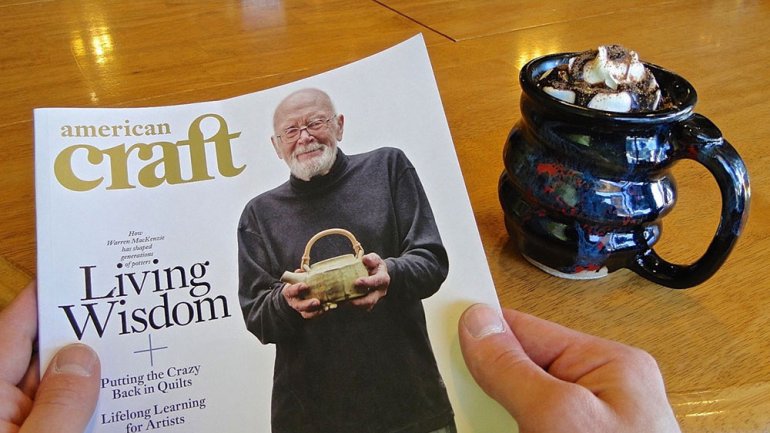A Potter's Journey: Part Eight
The Search for 1,000 True Fans
Renowned Minnesota potter Warren MacKenzie spent 37 years teaching college students to make pots. He retired in 1990 and continued enriching the ceramic world by practicing his craft and keeping his door open to the public. Two years ago, I drove to his studio in Stillwater unannounced. The 89-year-old potter paused his clay work to generously welcome me in for a tour.
MacKenzie gave clues to the ways potters could make and sell enough pottery to prosper. In its publication for MacKenzie’s Distinguished Artist Award in 1999, The McKnight Foundation revealed that he made about 7,000 pots per year working alone in his studio. In a MN Originals segment filmed in 2010, MacKenzie said that an affordable pot should cost $10. Combine these two figures with the fact that he sold nearly 100 percent of his pottery, and we are left with something I call the MacKenzie Equation: 7,000 pots per year x $10 per pot = $70,000 per year.
This equation is great because it is a simple way of stating what MacKenzie accomplished. Seven thousand pots seems like a massive number, but almost any potter could choose to strive for a higher output of quality pots. For example, the book Body of Clay, Soul of Fire tells how renowned potter Richard Bresnahan could finish 500 guinomi (sake cups) in a single day by the end of his Japanese apprenticeship.
As my career aligned with the teachings of MacKenzie and Bresnahan, the numbers from my business began to align with the numbers in the MacKenzie Equation. In 2014, I sold about 95 percent of my inventory (5,100 total pieces of pottery) and reached about $46,000 in sales. That works out to an average selling price of $9. My time was usually split evenly between pottery making and operating the business for an average workweek of around 70 hours.
During the 2014 NCECA [National Council on Education for the Ceramic Arts] conference in Milwaukee, I approached senior potter Danny Meisinger with the MacKenzie Equation. He pulled me behind his large booth display at the entrance of the expo hall, sat me down in a folding chair, and we talked for a good half hour. He said I owe it to myself to raise my prices and lower production – largely for health reasons, since pottery is so physically demanding. He predicted that if I made 7,000 pots in a year, it would probably raise sales, but it would not be sustainable.
Based on my 2014 business numbers, I think Meisinger was right. Both MacKenzie and I are fortunate enough to make pottery everyday, but the dependable college professor salary during his early years provided a significant advantage. The salary of a small business owner can be unpredictable. I’m changing my path to one that focuses more on innovation, with hopes that I will be able to work fewer hours and find greater success.
"If you don't have time, the truth is you don't have priorities. Think harder, don't work harder." ~ Tim Ferriss, The Tim Ferriss Show (podcast), episode 9, 2014
This quote is from a successful entrepreneur who owns and uses my pottery. He supports my vision of finding innovative ways to use technology to get pottery into the mainstream media. He inspired me to continue searching out technology moguls for advice.
Kevin Kelly is one of those people. He’s known globally as the founding executive editor of Wired magazine. In his blog post “1,000 True Fans” Kelly writes, “I don’t know the actual true number, but I think a dedicated artist could cultivate 1,000 True Fans, and by their direct support using new technology, make an honest living.” He goes on to tell how $100 spent by each True Fan just once each year not only brings a prosperous, six-figure livelihood, but also forms sincere relationships with individuals who truly love the artist’s work.
So how can I use technology to find 1,000 online art buyers when none of my Facebook photos have ever reached 100 likes? Small wins encourage me, like the #mugshotmonday photo of my pot that reached 136 likes when posted by the American Craft Council on Instagram. To find 1,000 True Fans, I’m searching for features from organizations with more than one million fans.
The images above show how I am attempting to achieve this feat. Over the past six months, I mailed eight boxes of free pottery to four different celebrities, always writing them personalized letters and approaching them on social media. Tensions ran high, as I typically received no responses. Then, a glimpse of light showed through: Tim Ferriss sent one tweet that drove more than 4,000 people to my website in two days, and then a Cosmic Mug sold for $100.65 to a gentleman halfway across the country. My spirits were raised by the potential gain of two True Fans.
“There’s nothing that breeds more energy and excitement than success.” ~ Michael Strand, Tales of a Red Clay Rambler (podcast), episode 85, 2014
Today marks the first day that “A Potter’s Journey” has aligned with the current timeline of my career. As I write my last article in this blog series, I am overwhelmed with gratitude. I am thankful to the American Craft Council for giving me a platform to share my ideas, and for risking its reputation on a vocal, emerging artist. I am indebted to the countless lessons given to me from people much older and wiser than myself. I am thankful to my local community who bought so many $10 pots – helping me to pay rent and to buy clay. I am hopeful that some day pottery will make it into the mainstream media. I’m thinking globally, acting locally, and continuing the search for 1,000 True Fans.




